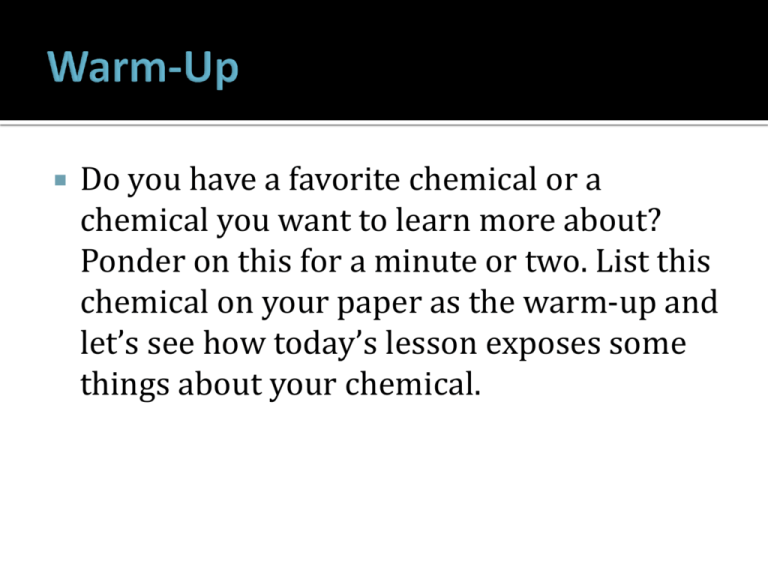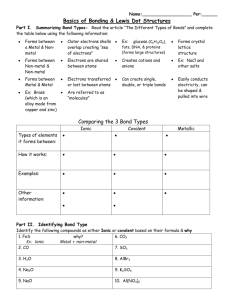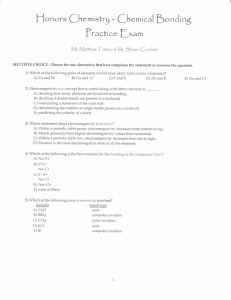Chemical Bonding ppt
advertisement

Do you have a favorite chemical or a chemical you want to learn more about? Ponder on this for a minute or two. List this chemical on your paper as the warm-up and let’s see how today’s lesson exposes some things about your chemical. Chemical Bonds Ionic & Covalent Bonding Bond Polarity & Electronegativity Lewis Structures and Kekule’ Structures E.Q.: How do I compare and contrast types of chemical bonds? When two or more atoms or ions are strongly attached to each other. There are three types: 1. Ionic Bonds: Transfer of electrons. 2. Covalent Bonds: Sharing of electrons. 3. Metallic Bonds: Atoms in metal are bonded to several neighboring atoms. Chemical symbol represents the nucleus and core electrons of the atom. Dots around the symbol represent valence electrons. First four dots are placed singly on each side of chemical symbol. Lewis symbols are used primarily for elements that acquire noble-gas configurations when they form bonds. Atoms often gain, lose, or share electrons to achieve noble gas electron configuration. Why? They have eight valence electrons! Eight is the max amount of electrons that an atom can possess in its outer shell. What does this mean? Once an atom has eight valence e-, it is said to be completely stable. * This rule has an exception (Transition Metals!) but it does introduce many concepts of bonding! All noble gases have eight valence electrons! Illustrate the Lewis Symbol for Oxygen. Predict what would happen to the Lewis symbol for oxygen if oxygen gained two valance electrons. Define a chemical bond. List the three types of chemical bonds. Illustrate Lewis symbols for oxygen, nitrogen, and sulfur. Chemical Party! By: Samantha Watt Chemical Bonds... Lewis symbols... Octet Rule... Study Your Notes! List the three types of chemical bonds. Chemical Bonds Ionic & Covalent Bonding Bond Polarity & Electronegativity Lewis Structures and Kekule’ Structures E.Q.: How do I compare and contrast types of chemical bonds? Metal + nonmetal Electrons are transferred. The transfer of e- from one atom to another. Rxn of sodium chloride below... The transfer of e- causes both ions to have an octet. e- transfer to form oppositely charged ions. Formation of Sodium Chloride! NaCl, KCl, and AlCl3... The principle reason that ionic compounds are stable is the attraction between ions of unlike charge. Energy is released (exothermic) during the rxn of Na and Cl. The sharing of e- between atoms. Mostly between nonmetals. Most substances that we come in daily contact with! Perfumes, water, plastic, gasoline, etc. Sharing of e- causes both atoms to have an octet. O2, CO2, and H2O... Glucose (C6H12O6)... Differentiate between an ionic bond and a covalent bond. Chemical Bonding... Ionic Bonding... Energetics of Ionic Bonding Covalent Bonding... Study Your Notes! List the three types of bonds and differentiate among them. Identify the following as covalent or ionic: Chemical Bonds Ionic & Covalent Bonding Bond Polarity & Electronegativity Lewis Structures and Kekule’ Structures E.Q.: Can I explain the effects of electronegativity on bond polarity? Covalent bonds are the ___________of ebetween atoms. When identical atoms bonds, as Cl2 and H2, e- pairs must be shared equally. Some covalent bonds, however, don’t always have equal sharing of e- . Nonpolar covalent bond – Equal sharing of e- pairs. Polar covalent bond – Unequal sharing of epairs. In nonpolar bonds, electrons are shared equally. Polar bonds are also depicted by partial positive and partial negative symbols … Unequal sharing in polar covalent bonds. Polar bonds are often depicted using colors to show electrostatic potential (blue = positive, red = negative). … or with a cross-based arrow pointing to the more electronegative element. ELECTRONEGATIVITY (EN) - Measure of the ability of an atom to attract e- to itself. EN is related to ionization energy. The greater the EN of an atom in a molecule, the more strongly the atom attracts e- in a covalent bond. ELECTRONEGATIVITY generally increases from left to right within a period, and it generally increases from the bottom to the top within a group. It would be a good idea to remember the four elements of highest electronegativity: N, O, F, Cl. The greater the difference in EN between two atoms, the more polar their bond! Insert picture here Give two examples of polar covalent bonds and nonpolar covalent bonds. Give two examples of ionic bonds. Bond Polarity... Electronegativity... Study Your Notes! Illustrate the Lewis symbols for all elements on the third period of the periodic table. Chemical Bonds Ionic & Covalent Bonding Bond Polarity & Electronegativity Lewis Structures and Kekule’ Structures E.Q.: How can I represent the structure of atoms and nature of chemical bonding through Lewis and Kekule’ structures? A combination of Lewis symbols... Obey the octet rule... Ex. CH4, NH3, H2O, and HF... Electrons not bonded – lone pairs. More Examples: C2H6, H2O2, and C8H18... Lewis Structures... Condensed Structures... Study Your Notes!








